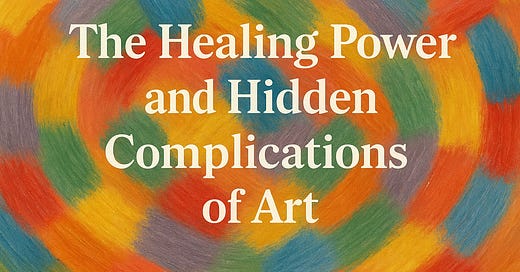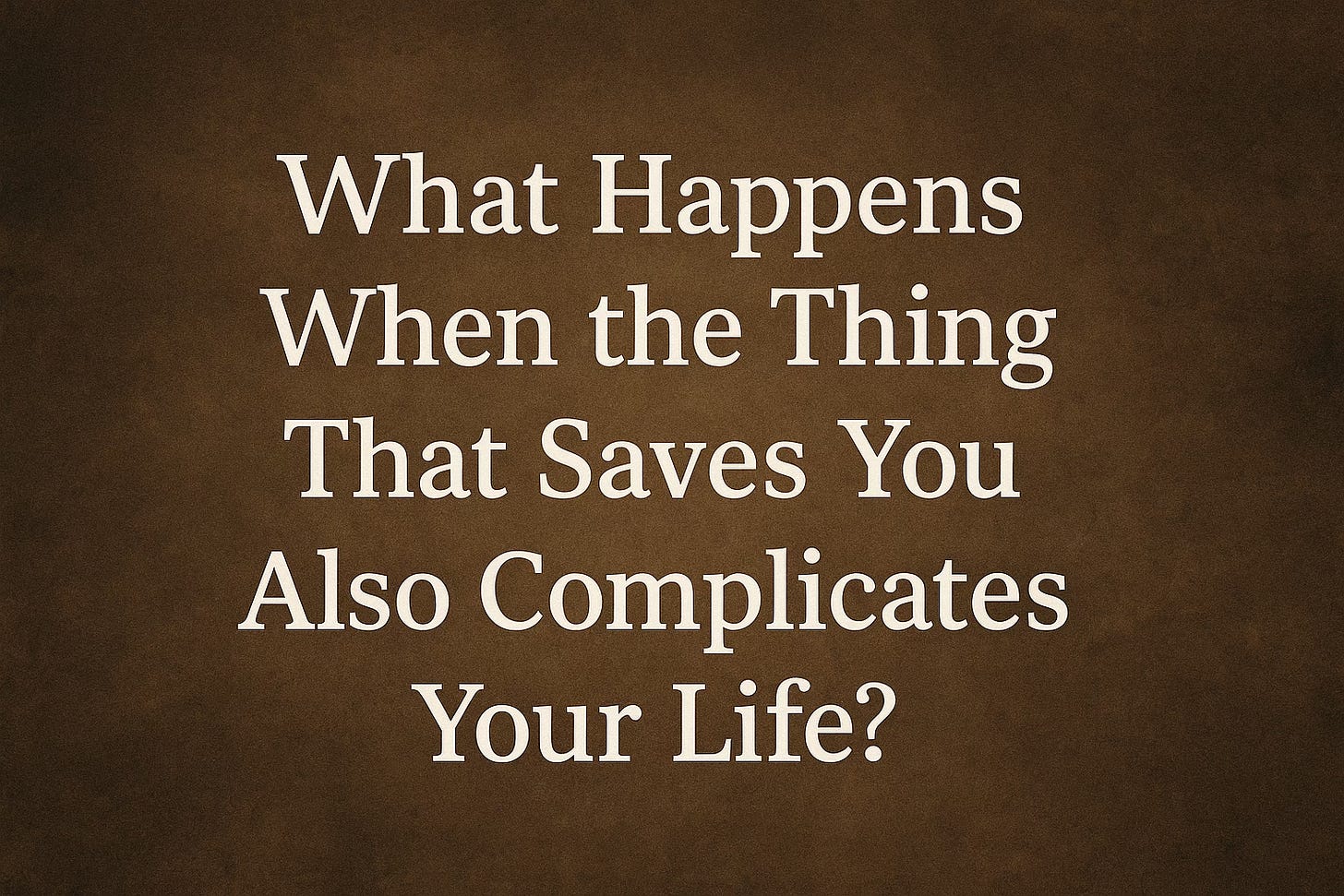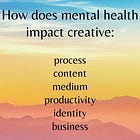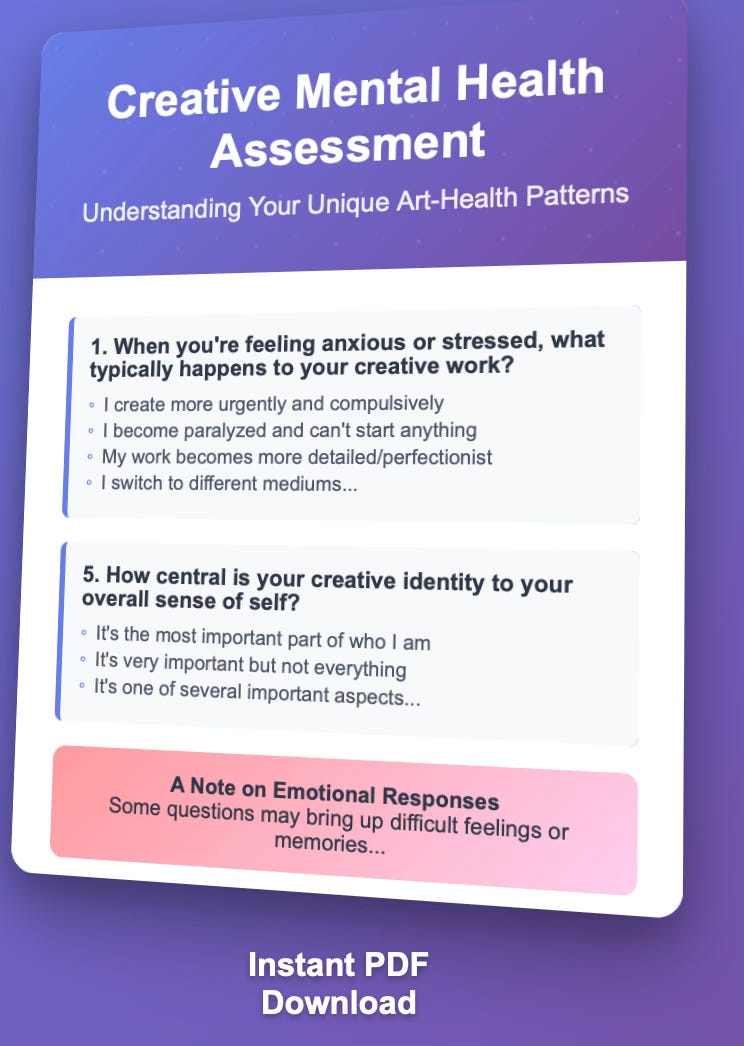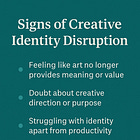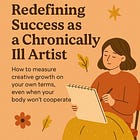The Healing Power and Hidden Complications of Art
What Happens When the Thing That Saves You Also Complicates Your Life?
Several years ago, I started asking a question that wouldn't leave me alone:
Why does no one talk about how our health (mental, physical, emotional, all of it) fundamentally shapes every aspect of our creative lives?
Not just the obvious ways, like depression making it harder to start projects or anxiety making it impossible to perform in public. I mean the intricate, often invisible ways our well-being touches everything: the colors we’re drawn to when we’re struggling, why we suddenly crave working small when life feels overwhelming, how perfectionism can transform from creative fuel into creative poison.
Through hundreds of conversations with artists, writers, musicians, and makers, I've discovered something both beautiful and complex: art can heal us and also complicate us, often at the same time.
When Art Becomes Medicine
Let me start with what we already know. Art can be medicine.
Countless creators describe art as a lifeline. For them, it gives form to chaos, shape to grief, and language to what feels unspeakable. In interview after interview, people have shared with me how their creative practices became safe spaces when nothing else in life felt steady. Some compare it to "playing pretend" in a way that allows a return to self, freedom, and play when the rest of life feels constrained.
Someone I know whose life has been marked by many, many (too many!) hospital visits told me that choosing the colors and material and pattern for crochet feels like “"the only thing about my life I can control,” at a time when she needed to feel that sense of control, illusory or not.
Psychologically, this aligns with art's ability to activate our parasympathetic nervous system, promoting rest and healing. It offers us control when life feels chaotic, voice when we feel silenced, and connection to our deepest selves. Art becomes a vital form of soul expression, and depriving oneself of this creative outlet is far from benign; it’s essential for our holistic well-being.
The Hidden Complications
However, the picture isn't always so serene, something I began exploring in depth with my last book, The Artist’s Mind.
What happens when the very thing that helps us cope also introduces a new layer of struggle? The intense demands and vulnerabilities inherent in creative work can, paradoxically, complicate life, especially when compounded by existing mental or physical health challenges.
Here are five interconnected patterns of complications I’ve noticed creatives often experience:
1. The Emotional Overwhelm Paradox
While art offers a powerful channel for emotional release, the line between healthy emotional processing and harmful emotional rumination is razor-thin for many creators. Creating can become a vehicle for avoiding root causes, intensifying distress rather than resolving it. Psychologically, this relates to emotional dysregulation, where intense feelings become difficult to manage. During periods of severe emotional overwhelm, the brain's prefrontal cortex, responsible for executive functions like rational thought and planning, can go "offline." This leaves the more primitive amygdala, which processes emotions like fear and anger, in the driver's seat. When creative work is undertaken in this state, it can inadvertently become a means of re-traumatization, reinforcing negative emotional cycles rather than offering a safe distance.
Even the highly sought-after "flow state" (you know, that immersive, optimal experience in creative work that people often hope to experience) can have a "flow paradox." While deeply rewarding, sustained periods of intense focus without adequate breaks or emotional processing can lead to emotional exhaustion and burnout. The inherent sensitivity that often fuels artistic depth can also become a vulnerability, making artists more susceptible to feeling overwhelmed by their own creative output.
2. The Perfectionism Prison
Striving for excellence is generally seen as a virtue, but for many creators, this drive can morph into a paralyzing perfectionism trap. As Dr. Brené Brown distinguishes, healthy striving is internally motivated and growth-focused, while perfectionism is externally driven, rooted in the fear of judgment and the desperate need for external validation. This can manifest as "all-or-nothing thinking," a common cognitive distortion where anything less than flawless is deemed a complete failure.
This distorted thinking leads to harsh self-judgment, unrealistic expectations, and chronic stress, often inhibiting creativity itself. Artists become paralyzed, abandoning projects or meticulously reworking them to the point of lifelessness. An artist might feel like their pieces are never finished because they’re never perfect. This relentless pursuit of an unattainable ideal transforms creativity from playful exploration into a high-stakes performance, triggering physiological stress responses that actively hinder creative flow. The irony is that true creative brilliance often emerges from embracing imperfection and taking risks, qualities stifled by the perfectionist's anxiety.
3. The Isolation Spiral
Creative work often necessitates solitude. However, for many artists, this necessary retreat can devolve into compulsive isolation, deepening mental health struggles like depression and anxiety. Dr. Johann Hari's work on disconnection highlights the profound human need for social connection. When creative practice becomes an individual's sole source of meaning and purpose, it can lead to a "behavioral activation deficit," where individuals withdraw from other supportive and rewarding life activities.
This often happens subtly: increased studio time might initially boost productivity, but over months, the lack of community connection can negatively impact mental health, eventually crippling creativity itself. A creative I’ve worked with shared how they began declining social invitations, theoretically to stay home and write, leading to a downward spiral where their mental health suffered, subsequently hindering their ability to create. The challenge lies in discerning between chosen, restorative solitude and a self-imposed prison driven by anxiety or depression, where the crucial human need for community remains unmet.
4. The Physical Toll That Becomes Emotional
The romanticized image of the artist often overlooks the intense physical toll of most creative work. Repetitive stress injuries, eye strain, back pain from long hours, or even the physical demands of specific mediums (e.g., sculpting, playing certain instruments) are common. This physical strain is not merely inconvenient; it profoundly impacts mental and emotional states.
As the concept of embodied cognition suggests, our physical experiences are intrinsically linked to our thoughts and feelings. Chronic pain, for example, doesn't just hurt; it can rewire the brain, affecting mood, attention, and executive functions like problem-solving and creative ideation. The "neural resource hypothesis" explains this: the brain's resources, typically used for cognitive tasks, are diverted to process pain signals, leaving less for creative thought.
Furthermore, artists in a "flow state" may compulsively ignore basic needs like hunger, sleep, and rest, leading to severe physical depletion and burnout. This isn't just exhaustion; artist burnout is a complex syndrome involving emotional exhaustion, depersonalization, and a reduced sense of personal accomplishment, often manifesting in physical complaints and a diminished creative capacity.
5. The Identity Crisis When Everything Changes
Perhaps the most profound complication arises when health challenges fundamentally alter an artist's capacity to create in familiar ways. For many, creative identity is not just a hobby; it's integral to who they are. When illness, disability, neurodivergence, or even medication changes their ability to engage with their art, it can trigger a deep identity crisis. This impacts their "possible selves,” which are the ideas about who they might become, and can lead to a profound sense of loss. This loss is often a kind of "disenfranchised grief," a form of grief not openly acknowledged or socially validated, making it deeply isolating.
The threat to creative identity can trigger an existential crisis, a profound inner conflict about life's meaning and purpose. Creativity often provides meaning, and its perceived loss can lead to anxiety, despair, and depression. In some cases, individuals with complex inner experiences (including those with Dissociative Identity Disorder) report that their various identities have distinct artistic styles and emotional expressions, which can lead to uncertainty about the coherence or quality of their work. This highlights how intricate internal landscapes can shape and complicate artistic output and self-perception. However, such challenges can also serve as catalysts for post-traumatic growth and resilience, pushing artists to adapt, explore new mediums, or discover new creative voices they might never have accessed otherwise.

Navigating Identity and Access in the Arts
These challenges are deeply shaped by broader social structures, particularly those related to disability and gender. Within the creative industries, systemic barriers often marginalize artists whose bodies or minds do not conform to normative expectations. For artists living with chronic illness, physical disabilities, or neurodivergent conditions such as ADHD, OCD, or DID, the art world can be an environment fraught with inaccessibility and misunderstanding. Their unique creative processes are often pathologized or dismissed, and traditional expectations around productivity and consistency can become exclusionary. Rather than viewing these artists through a lens of deficiency, a shift toward valuing diverse cognitive and physical experiences can foster more inclusive practices and spaces.
At the same time, gendered dynamics continue to shape how artistic labor is perceived and valued. Artists who are socialized into caregiving roles or expected to perform emotional labor may find their creative energies depleted or their work undervalued. Emotional expression in art, particularly when it challenges norms or asserts authority, is often differently received based on gender. Meanwhile, the romanticized image of the "suffering artist" tends to privilege certain identities while placing additional burdens on others to remain palatable or self-effacing. When factors like race, class, gender identity, and disability intersect, the result is a more complex and compounded set of challenges that shape not just artistic practice, but also access, recognition, and sustainability within creative careers.
A Framework for Understanding
What becomes clear through examining these complications is that creativity and health exist in a dynamic relationship, not simple causation. Art doesn't simply heal us, nor does it simply harm us. Instead, it amplifies and intensifies whatever psychological patterns we bring to it.
I’ve been working to understand this complex interplay through a six-part framework focusing on how mental health impacts: Creative Process, Creative Content, Creative Medium, Creative Productivity, Creative Identity/Self-Perception, and Creative Business. You can explore this framework more here:
Beyond the Binary
Recognizing the complications of creative practice does not mean we must fear it. On the contrary, it gives us the opportunity to respect its power and take care in how we use it. The goal is not to remove all struggle. Often, the tension and the breakthrough are linked. What we can do is learn to navigate that tension with greater skill, more clarity, and less harm.
Awareness becomes its own kind of creativity, a way to respond to the complexity without losing ourselves in it.
Want to Go Deeper?
I’ve designed a Creative Mental Health Assessment as a free PDF download if you’d like to think further about how these topics might apply to you.
It may help you identify:
Which of these complications most affect your practice
How your mental health symptoms intersect with your creative patterns
Where your greatest leverage points for healing and growth might be
Because while the complications are shared by many, the way they unfold in your creative life is entirely your own.
If you’d like to understand how these patterns show up in your own creative life, and how you might work with them instead of against them, I also offer 1:1 Healthy Creativity Conversations to assist in going deeper into this work. If you are interested in discussing what has emerged from this assessment, learn more and book your free consultation here.
If you find benefit in this work, know that it takes a lot of work. Support it if you can.

